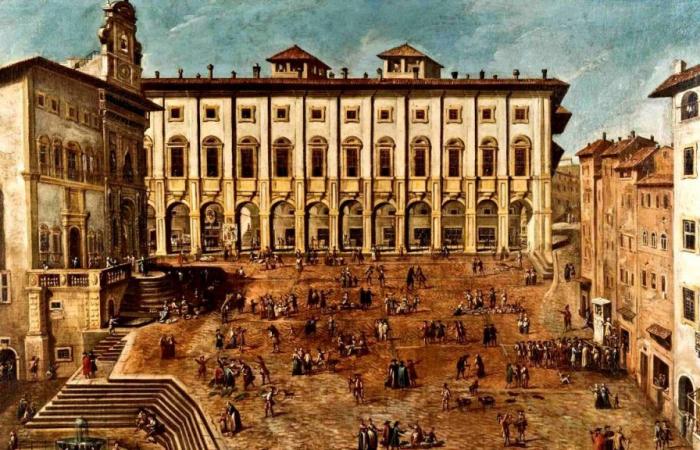An exhibition to illustrate the work of the architect Vasari one of the most notable feats he achieved in his city: the Loggia of Piazza Grande in Arezzo. It opens on Thursday 27th June at the Fraternita dei Laici of Arezzo (via Giorgio Vasari 6) “Honored And Gracious. The Loggia of Giorgio Vasari”exhibition process curated by Francesca Chieli which, thanks to a very rich documentary corpus, will delve into thebuilding ars Vasari. Thus the complex program continues celebratory events of “Arezzo. The city of Vasari”which until February 2025 will pay homage to the Arezzo master on the occasion of the 450th anniversary of his death, promoted by Municipality of Arezzo and CR Firenze Foundation with Guido D’Arezzo Foundationin collaboration with Regional Directorate of National Museums of Tuscany of the Ministry of Culture, Uffizi Galleries, with the curatorship of the scientific committee chaired by Carlo Sisi. Opening at 5.30pm at Ca.Mu. house of music of Arezzo, and at 9.00 pm in the Cathedral of Arezzo the homage will continue with a concert featuring the Vasari Organ by Luca di Bernardino da Cortona – dated to the mid-16th century. and placed on shelves of pietra serena, an early work by Giorgio Vasari -, with a repertoire that will range between pieces from the sixteenth, seventeenth and eighteenth centuries performed by Maestro Andrea Trovato (entrance to the concert is free, the exhibition will be open until 2 February 2025 every day from 10.30am to 6pm).
The setup will enhance the vast paper repertoire of the Fraternity, with particular attention to the construction of the Loggias which in the 16th century constituted a real urban renewal for Arezzo. From the panel with San Rocco by Bartolomeo della Gattadated 1479, which documents the building consistency of the square before Vasari’s work, ai first documents on the genesis of the work; from the famous wooden model of the loggias commissioned by the Rectors to Giorgio Vasari with a letter dated 19 July 1572 toconsent of the Grand Duke for the realization of the work; give her papers relating to the construction process at the “View of Piazza Grande” painted in the late 18th century and attributed to Cristoforo di Donato Conti. Also present precious testimonies on the artist’s life – starting from the baptismal certificate up to the copy of the will drawn up on 25 May 1568 by Raffaello Eschini at the Spedale degli Innocenti in Florence. Also on display is Portrait of Giorgio Vasari by Pietro Erminithe effigies of those who contributed with their bequests to the realization of the work and documents that attest to the “entirely Vasari” idea of bringing water to Piazza Grande and which will see the Fraternity involved in the new aqueduct undertaking.
“In the year dedicated to Giorgio Vasari, the exhibition narrative of one of the most significant sectors of his multifaceted artistic talent, namely architecture, was a must. Arezzo preserves a wonderful, majestic and scenographic work of this in the Loggias which bear the name of the Master and which changed the face of Piazza Grande, giving a Renaissance imprint to a purely medieval style space, today the true beating heart of the City. Thanks to the rich archive of the Fraternita dei Laici it will be possible to retrace the phases of its design and construction: an interesting journey through the history of architecture and that of our city”, comments the mayor Alessandro Ghinelli.
“The archive of the Fraternita dei Laici preserves considerable documentation on Giorgio Vasari – he explains Francesca Chieli – artist who always had very close relationships with the Ente Pio, accepting the position of Rector in March 1571 and declaring the same institution as universal heir in his will. The idea of telling the story of the Logge di Piazza Grande through the surviving correspondence, shared with the first rector Pier Luigi Rossi, was born from the awareness of the meaning that the new construction took on in a difficult political context, when Arezzo, during the 16th century, was under the strong influence of Florentine domination and in this specific case by the Magisterium of the Nine, the latter institution inaugurated by Cosimo I De Medici. In 1570 the Fraternity therefore promoted, in concert with the General Council of the Municipality and thanks to the collaboration of Giorgio Vasari, the construction of a Loggia which would define and qualify the ancient common audience, intervening in an area affected by archaeological remains. It was exciting to retrace the process of the building’s construction events, consult resolutions and registers which, like in a logbook, allowed us to document the twenty years and more of the construction site in Piazza Grande. Personally, I consider the initiative promoted by the Guido d’Arezzo Foundation to be commendable because it allowed us to delve deeper into Vasari’s connection with his city of origin, starting from direct testimony.”
“Arezzo. The city of Vasari” enjoys the patronage of Ministry of Culturepartner of the initiative State Archives of Arezzo, Diocese of Arezzo, Cortona and Sansepolcro, City Library of Arezzo, Fraternity of the Laity of Arezzo, Arezzo Intour Foundation. Graphic project by Wml design.






